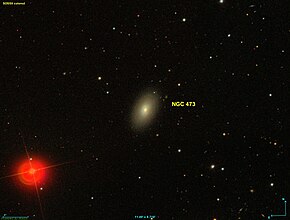
NGC 6744 is an intermediate spiral galaxy in the constellation Pavo (Peacock). Its velocity with respect to the cosmic microwave background is 802 ± 3 km/s, which corresponds to a Hubble distance of 38.6 ± 2.7 Mly (11.82 ± 0.83 Mpc). However, 21 non redshift measurements give a distance of 23.63 ± 1.68 Mly (7.244 ± 0.514 Mpc). It was discovered on 30 June 1826 by Scottish astronomer James Dunlop, observing from Parramatta, Australia.
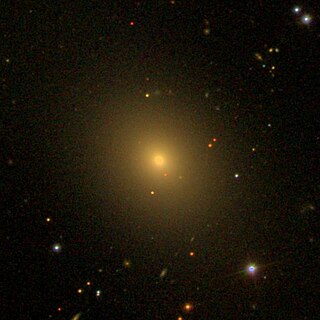
NGC 57 is an elliptical galaxy in the constellation Pisces. It was discovered on 8 October 1784 by astronomer William Herschel.
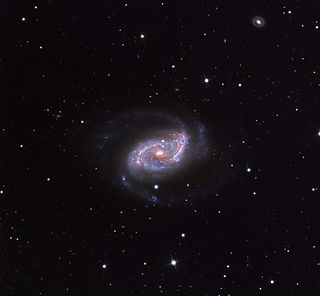
NGC 5248 is a compact intermediate spiral galaxy in the constellation Boötes. Its velocity with respect to the cosmic microwave background is 1437 ± 20 km/s, which corresponds to a Hubble distance of 69.1 ± 4.9 Mly (21.19 ± 1.51 Mpc). However, 17 non redshift measurements give a much closer distance of 42.52 ± 3.16 Mly (13.038 ± 0.969 Mpc). It was discovered on 15 April 1784 by German-British astronomer William Herschel.

Arp 7 is a spiral galaxy in the constellation Hydra. Redshift-independent measurements of its distance vary widely, from 5.9 Mpc to 83.7 Mpc. Its morphological classification is SB(rs)bc, meaning it is a barred spiral galaxy with some ring-like structure.

NGC 1169 is an intermediate barred spiral galaxy in the constellation of Perseus. NGC 1169 has a reddish center, indicating the region is dominated by older stars. In contrast, the outer ring contains larger blue-white stars, a sign of recent star formation. The entire galaxy is rotating at approximately 265 km/s.

NGC 132 is a spiral galaxy in the constellation Cetus. Its velocity with respect to the cosmic microwave background is 5015 ± 25 km/s, which corresponds to a Hubble distance of 241.3 ± 16.9 Mly (73.97 ± 5.19 Mpc). In addition, three non redshift measurements give a distance of 250.81 ± 2.14 Mly (76.900 ± 0.656 Mpc). It was discovered on 25 December 1790 by German-British astronomer William Herschel.

NGC 167 is a spiral galaxy located approximately 172 million light-years from the Solar System in the constellation Cetus. It was discovered in 1886 by Francis Preserved Leavenworth.

NGC 227 is a lenticular galaxy located approximately 237 million light-years from the Sun in the constellation Cetus. It was discovered on October 1, 1785 by William Herschel.

NGC 297 is an elliptical galaxy in the constellation Cetus. It was discovered on September 27, 1864, by Albert Marth and is classified as type E3, based on galaxy morphological classification.
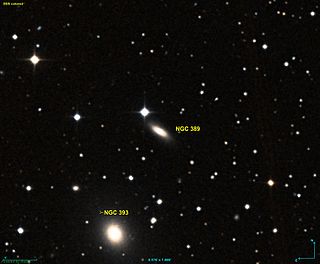
NGC 389 is a lenticular galaxy located approximately 239 million light-years from the Solar System in the constellation Andromeda. It was discovered on September 6, 1885 by Lewis Swift. It was described by Dreyer as "extremely faint, extremely small, round, star near."

NGC 806 is a spiral galaxy approximately 166 million light-years away from Earth in the constellation Cetus. It was discovered by American astronomer Lewis A. Swift on November 1, 1886 with the 16" refractor at Warner Observatory.

NGC 4598 is a barred lenticular galaxy located in the constellation Virgo. NGC 4598 was discovered by astronomer William Herschel on April 15, 1784. The distance to NGC 4598 has not been accurately determined; measurements vary from 64 to 102 million light-years. According to the NASA/IPAC Extragalactic Database, its redshift based distance is 102 Mly (31.3 Mpc) while its redshift independent based distance is 88.71 Mly (27.200 Mpc). Also, according to SIMBAD, its distance is 63.7 Mly (19.54 Mpc). NGC 4598's average distance is 84.8 Mly (26.0 Mpc). NGC 4598 is usually considered to be a member of the Virgo Cluster. However, P. Fouqu´e et al. suggests it may be a background galaxy independent of the main cluster.

NGC 2300 is a lenticular galaxy in the constellation Cepheus. Its velocity with respect to the cosmic microwave background is 1876 ± 7 km/s, which corresponds to a Hubble distance of 90.2 ± 6.3 Mly (27.67 ± 1.94 Mpc). However, 11 non redshift measurements give a distance of 131.98 ± 21.75 Mly (40.464 ± 6.668 Mpc). The galaxy was discovered in 1871 by French astronomer Alphonse Borrelly using an 18 cm telescope.

NGC 4694 is a lenticular galaxy in the constellation Virgo. Its velocity with respect to the cosmic microwave background is 1481 ± 23 km/s, which corresponds to a Hubble distance of 71.3 ± 5.1 Mly (21.85 ± 1.57 Mpc). However, six non redshift measurements give a distance of 28.51 ± 7.23 Mly (8.742 ± 2.218 Mpc). The galaxy was discovered by William Herschel on March 15, 1784.

NGC 918 is a barred spiral galaxy in the constellation Aries, about 67 million light years from the Milky Way. It was discovered by John Herschel on Jan 11, 1831.

NGC 997 is an interacting galaxy in the constellation of Cetus. The galaxy was discovered by Albert Marth on 10 November 1863. It has a regularly rotating central molecular gas disk, containing a black hole of between 4 x 107 and 1.8 x 109 solar masses. Its speed relative to the cosmological background is 6,270 ± 45 km/s, corresponding to a Hubble distance of 92.5 ± 6.5 Mpc (~302 million ly).

NGC 1004 is an elliptical galaxy in the constellation Cetus. Its velocity with respect to the cosmic microwave background is 6242 ± 26 km/s, which corresponds to a Hubble distance of 300.3 ± 21.1 Mly (92.07 ± 6.46 Mpc). It was discovered on 1 December 1880 by Édouard Stephan.

NGC 7716 is an intermediate spiral galaxy located in the constellation Pisces. Its speed relative to the cosmic microwave background is 2,201 ± 26 km/s, which corresponds to a Hubble distance of 32.5 ± 2.3 Mpc. NGC 7716 was discovered by British astronomer John Herschel in 1831.
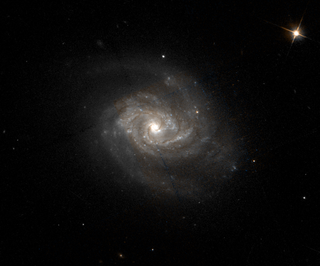
NGC 664 is a spiral galaxy in the constellation of Pisces. Its velocity with respect to the cosmic microwave background is 5137 ± 21 km/s, which corresponds to a Hubble distance of 247.1 ± 17.3 Mly (75.77 ± 5.31 Mpc). In addition, six non redshift measurements give a distance of 218.91 ± 3.66 Mly (67.117 ± 1.123 Mpc). It was discovered by British astronomer John Herschel on 24 September 1830.

NGC 1233 is a spiral galaxy in the constellation of Perseus. Its velocity with respect to the cosmic microwave background is 4218 ± 14 km/s, which corresponds to a Hubble distance of 202.9 ± 14.2 Mly (62.22 ± 4.36 Mpc). In addition, three non redshift measurements give a distance of 211.35 ± 2.14 Mly (64.800 ± 0.656 Mpc). The galaxy was discovered by French astronomer Édouard Stephan on 10 December 1871. It is also thought to have been observed by Lewis Swift on 21 October 1886, and later listed as NGC 1235.
